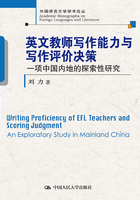
2.4 Summary
This chapter has shown that,although no theories of writing is currently available for measuring the writing proficiency of pre-service EFL teachers,a list of nineteen discourse features has been proposed based on the requirements/standards of language teachers regarding writing proficiency,which provides an underlying theoretical foundation for examining the writing proficiency of pre-service EFL teachers.The foregoing review of empirical L2 studies also shows that the attempts have been made to evaluate the essay quality by experimenting with a number of measures.Table 2-5 presents the broad categories underlying the constructs of writing proficiency in the left-hand column.The right-hand column presents the relevant measures that have been chosen as operationalization of these constructs,which will be employed in Study One.

注释
[1]The capitalized features,i.e.,“Lexical Resources”are category labels developed in the current study.The italic features,i.e.,“error-free t-unit ratio”are measures of features employed in empirical studies.The features with normal formats such as“fluency”are general terms for text features employed in the writing research.
[2]Liu,Li.,Mak Barley and Jin Tan,“Anchoring writing scores with candidates'performances:IELTS and TOEFL perspectives,”p.177.
[3]Liu,Li.,Mak Barley and Jin Tan,“Anchoring writing scores with candidates'performances:IELTS and TOEFL perspectives,”p.179.
[4]David Malvern,Brian Richards,“A new measure of lexical diversity,”in Evolving Models of Language,p.91.
[5]Lourdes Ortega,“Syntactic complexity measures and their relationship to L2 proficiency:A research synthesis of college-level L2 writing,”p.492.
[6]Flahive,Douglas and Snow Beckie,“Measures of syntactic complexity in evaluating ESL compositions,”in Research in Language Testing,p.172.
[7]Alister Cumming,Robert Kantor,Kyoko Baba,Usman Erdosy,Keanre Eouanzoui and Mark James,Analysis of Discourse Features and Verification of Scoring Levels for Independent and Integrated Prototype Written Tasks for the New TOEFL Test(TOEFL Monograph 30).(Princeton,NJ:ETS,2006),p.59.
[8]Stuart Shaw and Peter Falvey,“The IELTS writing assessment revision project:Towards a revised rating scale,”p.42.
[9]Halliday Michael Alexander Kirkwood and Ruqaiya Hasan,Cohesion in English(London:Longman,1976),p.4.
[10]Avon Crismore,Raija Markkanen and Margaret Steffensen,“Metadiscourse in persuasive writing:A study of texts written by American and Finnish university students,”p.39.
[11]Alister Cumming,Robert Kantor and Donald Powers,Scoring TOEFL Essays and TOEFL 2000 Prototype Tasks:An Investigation into Raters’Decision Making and Development of Preliminary Analytic Framework(Princeton,NJ:ETS,2001),p.3.
[12]Usman Erdosy,Exploring Variability in Judging Writing Ability in a Second Language:A Study of Four Experienced Raters of ESL Compositions(Princeton,NJ:ETS,2004),p.10.
[13]Alister Cumming,Robert Kantor,Donald Powers,Terry Santos,and Carol Taylor,TOEFL 2000 Writing Framework:A Working Paper(Princeton,NJ:ETS,2000),p.18.
[14]Paul Stapleton,“Assessing critical thinking in the writing of Japanese university students:Insights about assumptions and content familiarity,”p.517.
[15]Joanna Crammond,“The uses and complexity of argument structures in expert and student persuasive writing,”in Written Communication,p.236.